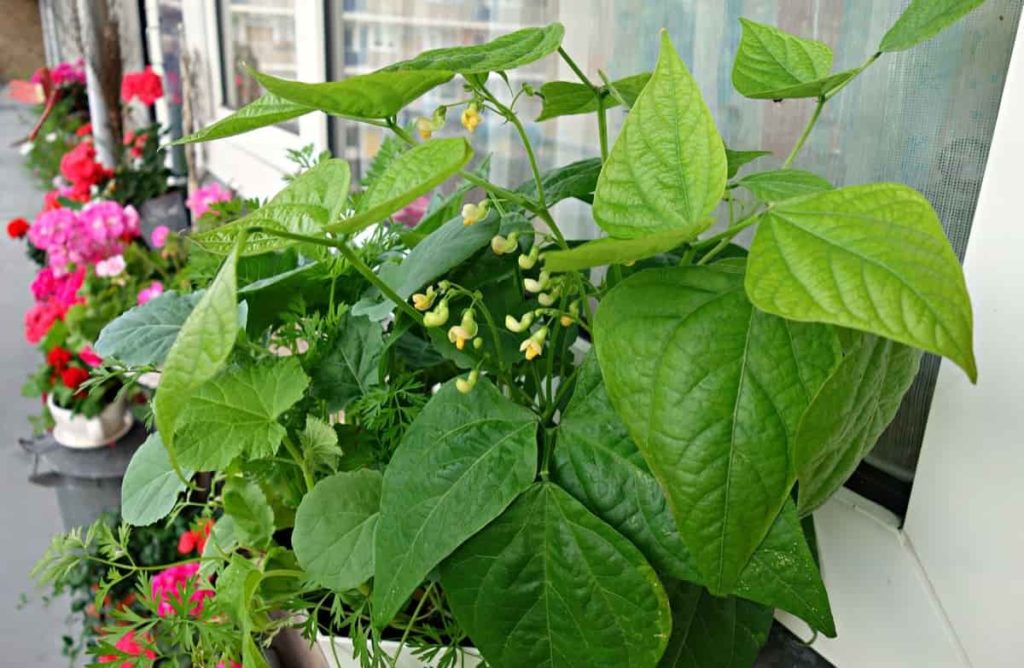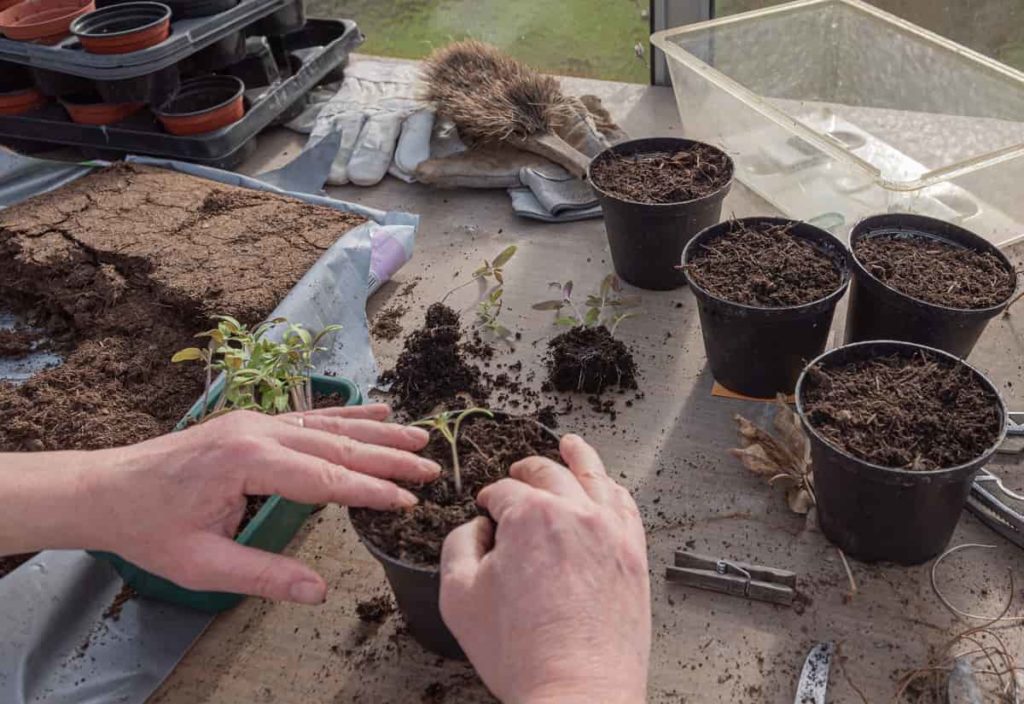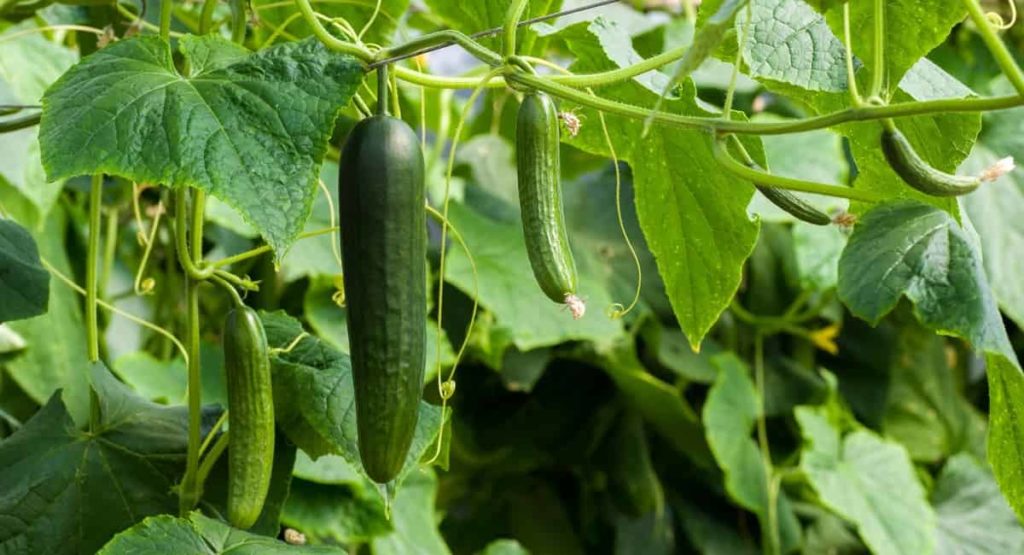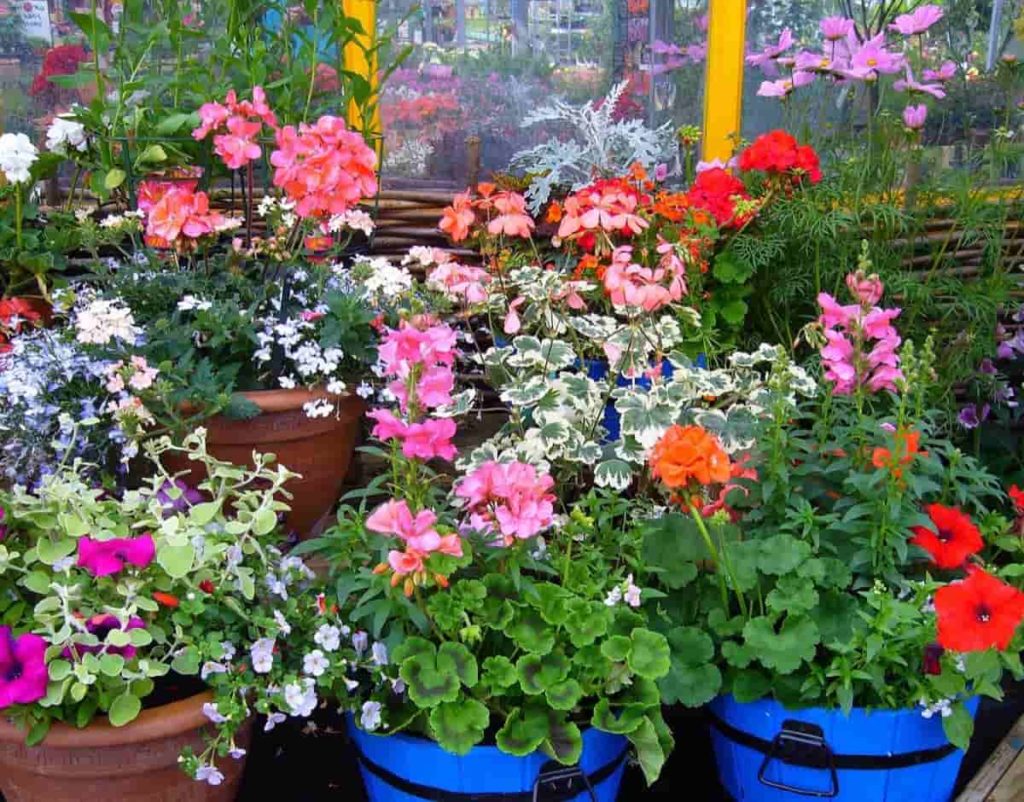A landscape is enhanced by the presence of plants. They highlight even small details. Vegetables are also a healthy source of food. In contrast, poor soil, inadequate drainage, and hard surfaces can seriously affect a plant’s capacity to thrive. Additionally, some individuals are physically unable to plant at ground level because of their disability. When it comes to growing plants, all things can be a hurdle.

Many of these difficulties can be addressed by container gardening, offering everyone the option to grow their food. You can use this information to plan and develop container gardens that fit your landscape. This article provides information about how to start container gardening that best suits the climate of Oklahoma and discusses the best Oklahoma container gardening plants. We hope this article acts as a guide for the best flowers, fruits, vegetables, and herbs to plant in Oklahoma.
USDA hardiness zones of Oklahoma
Central, southern, and eastern Oklahoma are humid subtropical regions, with a humid continental climate in the north and a humid subtropical climate elsewhere. It is usual for the state to have severe weather because of its closeness to Canada, the southwest United States and Mexico, and the Gulf of Mexico’s warm and humid air. Thunderstorms, tornadoes, and hail that aren’t seen anyplace else in the county can be addressed to these three locations and their significantly diverse air currents.
More than 60 tornadoes touch down in the state each year. The state has the driest winters and most spring rains in May. It gets up to 79 degrees in the summer and 39 degrees in the winter. There are six to eight growth zones in Oklahoma. Gardeners can use growing zones, also known as planting zones, to determine what flowers, plants, and vegetables are best in certain areas. We can tell which plants have the best chances of surviving winter by looking at their zones.
They provide advice on what to plant and when to plant it, and it’s a comprehensive guide. First and last frost dates are used to determine Oklahoma’s planting zones. Use only plants suited for your Oklahoma planting zone or below when starting a garden. For example, if you’re planting in zone 6a, stick to hardy plants in zones 1 through 6.
In case you missed it: Urban Vegetable Gardening Ideas, Tips, Techniques

This ensures that plants can withstand the harsh winter weather in the area. It’s important to follow the hardiness zones to grow plants. Garden phlox and rudbeckias are easy to grow, as are daylilies and peonies. All around the state, lettuce, chard, snow peas, kale, herbs, and summer squash thrive.
Oklahoma container gardening: How to start
Select the right size container for your plants
To assist you in determining the correct pot size for your plants, here are a few guidelines: Containers with a minimum width of 12 inches are ideal for various plants. A minimum of 8 inches is required for most annuals, although grasses and some plants may need more. A container with straight or curved top edges is perfect for easy access.
Consider the material and placement of the container
Terracotta containers: This kind of reddish-brown clay pot is a timeless classic. When purchasing a terra-cotta pot for your plants, you’ll want to avoid unglazed terra-cotta since it’s quite porous.
Window boxes: A window box is a container that can be attached to a window sill and used to decorate the outside of your house. Window boxes are ideal for growing flowers, herbs, and other beautiful and nutritious plants. Plastic, wood, fibreglass, and metal are just some materials used to make window boxes.
Hanging baskets: The drainage and aeration provided by hanging baskets are essential for the plants’ health. Hanging them in an area with a lot of wind might be dangerous.
Plastic pots: Most often, plastic pots are the cheapest and lightest of all the container alternatives, but they are adaptable and can store a lot of water. Growing edible plants in plastic pots should be approached with care because toxins in certain plastics might seep into the soil.
Metal containers: Metal planters are a modern container form that is long-lasting and less likely to shatter than clay pots. The main disadvantage of these containers is that they heat up quickly in direct sunlight, leading to dry soil and damaged plant roots.
Grow bags: Shallow-rooted plants do best in grow bags made of plastic or fabric. And since they’re so easy to grow potatoes in, they’re an excellent investment.
Lightweight materials, such as metal or composite, are best for deck or rooftop containers. With their nonporous nature and the ability to retain water, these and certain glazed ceramic pots are also beneficial. While unglazed porous terra-cotta develops a lovely patina over time, this kind of tile dries out soil more rapidly.
In case you missed it: How To Start Backyard Vegetable Garden in the USA

To prevent the soil from evaporating, drainage holes in the pot should be filled with pottery shards, stones, or a tiny piece of screening. Use pot feet or a plant stand to raise pots off a wooden deck if you have one so that water doesn’t sit on the wood and damage it.
Select your potting mix for your container garden
You shouldn’t use soil from your garden. Insects, fungi, and weed seeds can all be found, making them dangerous. Visit your local garden store to purchase potting soil. Peat moss, vermiculite, and, in certain cases, decayed organic matter are among the loose and light components that make up this combination—plant succulents and cacti in a mix developed specifically for this purpose.
Potting mix with a time-release fertilizer and polymer crystals can lessen the amount of time spent caring for your plants. A time-release fertilizer and moisture crystals like Soil Moist can be used if that mix is not readily accessible. Add the ingredients to the potting mix as directed on the packaging.
Prepare the container
Placing huge containers before filling them where they will be used is a good idea. They could be too heavy to relocate after they are full and water. Cover the holes in the bottom of an empty pot using a basket-type coffee filter or a shard of a shattered pot. Potting mix will not wash away, but water will be able to escape. Check the soil’s moisture content before putting it in. Open the bag and read the instructions on how to moisten it properly.
Most recipes call for adding water gradually and mixing the mixture with your hands. You can use this as a guideline for how much water to add to the mix. Add the soil into the container. Make sure the plant’s base is approximately an inch from the top of the container with adequate potting mix. Using your fingertips, gently press down the earth before planting to remove any large air pockets. Don’t cram it in too much.
Planting your plants in containers
Gently press the edges of their nursery pots to release the root ball so that you can easily remove the plants. Squeezing the plant might damage it. Then, place your plants in the potting mix, so their root balls are a few inches below the container’s rim.
Later, watering will be simple. Add extra potting mix to the plants’ area, ensuring that the stems are no deeper in the soil than in their nursery pots. To minimize huge air pockets, gently push down on the mix around your plants with your hands.
In case you missed it: How to Grow Jasmine Flowers at Home in the USA: From Seeds, Cuttings, Faster, In Backyards, Indoors, and In Containers

Water your container plants
Watering containers is different from watering plants on the ground. Because it’s less compact, potting soil has less water. The container restricts the soil’s water storage. They don’t have much heft to keep them cool since they’re on the surface. Your plants will die if you give them too much or too little water. The goal is to keep the soil moist, but not soaking wet, during the process.
Many container plants need to be watered twice a day when hot outside. Water the soil straight from the surface using a watering can or garden hose. You can keep your plant’s healthy while away from home by installing a drip watering system.
Sunlight is required for your container plants
Most plants need 7 to 12 hours of direct sunshine each day. Find shade-tolerant types like spinach and chard instead. Use seed packages to figure out how much light each species need. Definitions for packet terms are as follows:
- Full sun: Direct sunshine for 6 to 8 hours a day is considered full sun.
- Partial sun: Plants need between 4 and 6 hours of sunlight every day, ideally between dawn and dusk.
- Shade: Less than four hours of direct sunshine each day, with filtered sunlight for the remaining day.
You may need to supplement your containers’ natural light with plant grow lights during the winter months. These lights mimic the sun’s rays, allowing plants to survive even in the year’s darkest months.
Fertilizer requirements for your container plants
Compost teas, worm teas created from worm castings, liquid organic fertilizers, fish emulsion, and kelp meal all provide micronutrients and organic compounds in addition to the nitrogen, phosphorus, and potassium that plants need. Organic fertilizers are better than synthetic fertilizers since they don’t burn your plants and provide all the macronutrients, minerals, amino acids, and vitamins your plants need.
Most of these plants release their nutrients gradually, and a thorough watering kicks them off, so you get long-term, beneficial consequences. When fertilizing, timing is essential since the plant’s nutritional requirements alter as it develops. As a general rule of thumb, annual plants, such as roses and geraniums, benefit best when initially planted with a high-nitrogen, low-phosphorus solution. Fertilizer has to be applied weekly or biweekly for container plants since watering causes nutrients to drain from the soil.
Growing vegetables in containers in Oklahoma
Kale: Kale thrives in Oklahoma’s springs and falls. Kale can be cultivated year-round, unlike the others. The only ornamental plant on this list is kale, adding color, charm, and beauty to any garden. Kale can be best grown in containers in Oklahoma. This adaptable veggie is excellent for Oklahoma beginners. Aphids are a pest for many vegetables. Oklahoma’s aphids can stunt or destroy kale.
In case you missed it: How to Grow Rose Flowers at Home in the USA:: From Seeds, Cuttings, Faster, In the Backyard, Indoors, and Containers

Lettuce: Lettuce can be a bit picky. Lettuce thrives in containers, so even if you have a little balcony, you can still enjoy a healthy meal of greens. In that order, leaf and romaine varieties are the simplest.
Peppers: Peppers are fun to cultivate and provide a lot of fruit. You can grow hot, sweet, or both. They love heat and thrive anyplace with eight hours of sunshine every day.
Peas: Peas can be grown in spring and October. English, snow, and sugar snap peas are pea varieties. They provide nitrogen for succession planting. Most pea varieties need assistance. Plant in early spring. When it’s warm, and they’re done producing, remove them and plant something different.
Cucumbers: It’s usual for people to grow cucumbers in containers since they’re a fast-growing plant. Large plastic or ceramic pots work best for these water-loving plants. Container gardening is an excellent approach to providing cucumbers with the warmness they want.
Growing herbs in containers in Oklahoma
Basil: In terms of ease of growing, basil is a strong contender. It can be grown in any soil and doesn’t need fertilizer or special care. It simply needs to be watered once or twice a week. Basil is an excellent choice for window boxes, garden containers, and locations with limited space.
Oregano: Oregano is Oklahoma’s coldest-hardy herb. Oregano can be grown year-round. Oregano is an ornamental herb. This means it can beautify any yard. Oregano is a perennial plant, which is an advantage. Once planted, you can consume it every year.
Mint: Mint thrives in Oklahoma’s frigid temperatures. Mint grows easily. It doesn’t require fertilizer, little water, soil, or pruning. Mint thrives in containers. One can grow them in their home, garden pot, or window box.
Sage: Sage grows as the summers warm up. It is a low-maintenance herb. Sage is an effective insect repellent for your garden. You can burn or apply it to yourself to repel pests. They thrive in window boxes, raised beds, containers, and poor soil.
Thyme: Thyme is versatile. Certain varieties can be cultivated in cold, others in warm, and some in both. Thyme is a spring-to-fall plant. You can eat or store it year-round. Plant it, then water it throughout the summer.
Growing flowers in containers in Oklahoma
Petunias: Petunias bloom till November and love the heat. Heat means more flowers. Flowers need constant care. Wave petunias are easy to cultivate. They bloom without deadheading. Some flowers need sun or shade. They grow in window boxes, hanging baskets, and anywhere.
Daisies: Daisies are an easy-care plant. Plant bulbs in the autumn and mature plants in the spring to enjoy this low-maintenance beauty. Not all of these plants can handle heat and light. Daisies thrive in heat and sun, making them the ideal flower for any yard.
Dahlias: Dahlias grow easily. Never fertilize, hardly water, plant in any soil, and never worry about it! Dahlias thrive in containers. It is suitable for container gardening.
Zinnias: You can plant Zinnias in springtime for a headstart, but they can also be planted in the summertime and still bloom and flourish.
Tulips: It’s black, purple, red, yellow, pink, white, orange, etc. It adds color everywhere. These are ideal for containers.
In case you missed it: How to Grow Indian Vegetables in USA: at Home, in Backyard, and Pots – A Step-by-step Guide

Growing fruits in containers in Oklahoma
Apples: Oklahoma’s spring and autumn are ideal for apple trees. Flowers and fruit can flourish even when there’s late-spring snow or frost. Apple trees are easy to grow. It doesn’t require fertilizer, water, special soil, or pruning. Apple trees can be planted in containers if you have limited space.
Pears: Oklahoma pear trees are also cold-hardy. Pears flower and produce fruit sooner than apple trees. Pear Trees can be planted in Oklahoma gardening containers. This adaptable fruit is excellent for Oklahoma beginners.
Plums: Plums thrive in heat, unlike other fruit plants. Warmer winters and springs help this early summer fruiting tree produce more plums. Plum trees won’t grow above 8 to 10 feet tall and 6-8 feet broad, making them ideal for containers.
Gooseberries: Gooseberries are prolific and need little space. They like a sunny, protected position but will give fruit in the shade. Leave a gooseberry-sized gap around the pot to promote airflow.
Raspberries: You can plant summer and autumn-fruiting raspberries in containers, extending your yield. Choose summer fruiting varieties if space is restricted. Provide a sunny, protected area.
- How to Grow Hibiscus from Flower
- Plantation Ideas for Home Decoration: A Beginners Guide
- Flower Garden Designs and Layouts for Beginners
- Planting and Spacing Techniques in Papaya: A Beginner’s Guide
- Growing Gold: Essential Techniques for Planting Pineapples
- How to Make Kalanchoe Plant Bushy: Home Remedies and Solutions
- 11 Reasons Why Your Gardenia is Not Blooming: Home Remedies and Solutions
- Eco Elegance: The Guide to Designing a Drought-Tolerant Landscape
- Gardening on a Slope: Strategies for Hillside Landscaping
- Nourish and Flourish: Top Organic Mulches for Thriving House Plants
- Everything You Want to Know about Indian Mogra Flower: Discover Uses and Growing
- Green Thumb Success: Expert Tips for Cultivating Greenhouse Pumpkins All Year Round
- Maximize Growth & Flavor: The Ultimate Guide to Companion Planting in Herb Gardens
- How to Control Rhododendron Problems Naturally: Home Remedies and Organic Ways to Fix Them
- Natural Magic: The Remarkable Benefits of Cinnamon for Plants
- Best Steps to Revive Dying Tulip with Natural and Organic Treatment
- 10 Reasons Why Your Angel Trumpet is Not Blooming: Remedies and Treatment
- How to Fix Periwinkle Leaf and Flower-Related Problems: Natural Remedies and Solutions
- How to Fix Zinnias Leaf and Flower Problems: Discover Natural and Home Remedies
- Organic Steps to Induce Lemon Tree Flowers: A Comprehensive Guide
- Bloom Booster: Crafting the Perfect Homemade Bougainvillea Fertilizer
- Optimizing Growth: A Guide to Applying NPK Fertilizer for Potted Plants
- 10 Best Homemade Fertilizers for Rubber Plant: DIY Recipes and Application Method
- How to Boost Female Pumpkin Flowers: Effective Steps for More Flowers and High Yields
- Transform Your Indoor Garden: Top Benefits of Pink Salt for Houseplants
- 10 Best Homemade Fertilizers for Peacock Plants (Calathea): Easy DIY Guide
- Unlock Blooms: 9 Reasons Why Your Potted Chrysanthemum is Not Blooming
- 8 Reasons Why Your Potted Hibiscus is Not Blooming: Fix it with Simple Solutions
- Unlock Blooms: 9 Key Reasons Your Potted Frangipani Won’t Flower
- 10 Reasons Why Is My Ice Plant Not Blooming: Remedies and Treatment
- 10 Reasons Why My Potted Hydrangea Not Blooming: Treatment and Remedies
- 10 Reasons Why is My Wisteria Not Blooming: Remedies and Treatment
- 10 Reasons Why is My Goldfish Plant Not Blooming: Remedies and Treatment
- Maximize Your Space: Ultimate Guide to Balcony Gardening with Grow Bags
- 10 Reasons Why Your Iris is Not Blooming: Remedies and Treatment
- 10 Reasons Why Your Anthurium Plant is Not Blooming: Treatment and Remedies